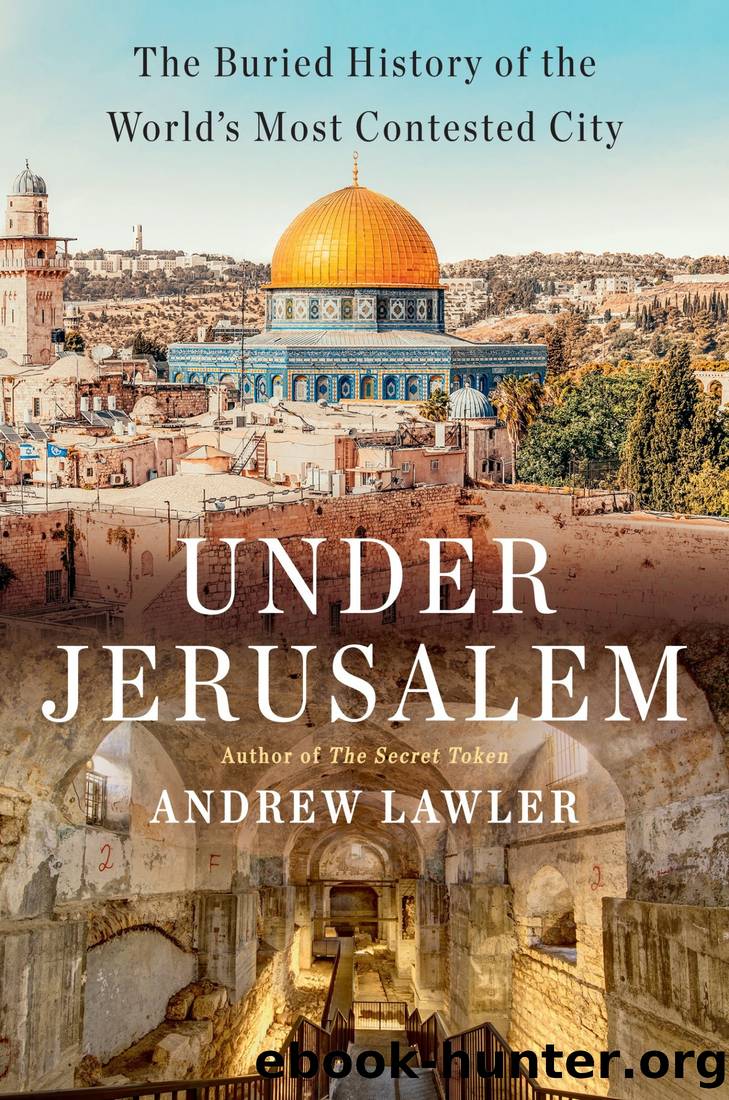Under Jerusalem: The Buried History of the World's Most Contested City by Andrew Lawler

Author:Andrew Lawler [Lawler, Andrew]
Language: eng
Format: epub
Tags: History, Middle East, General, Religion, Social Science, Archaeology
ISBN: 9780385546850
Google: uAs1zgEACAAJ
Amazon: 0385546858
Goodreads: 57004605
Publisher: Doubleday
Published: 2021-11-01T22:00:00+00:00
On a hot afternoon on September 4, 1995, Israeli prime minister Yitzhak Rabin stood beneath a tent adjacent to an archaeological excavation to launch the celebration that was Kollekâs brainchild. The site was at the base of the ridge that Jews now called the City of David. For Palestinians, this was the Silwan suburb of Wadi Hilweh, or âbeautiful valley.â The gentle fields of cauliflower and grazing land of Warrenâs and Blissâs day had given way to concrete houses and dusty streets. Security was tight as Israeli forces patrolled the roofs of nearby Arab homes.
âThree thousand years of history look down upon us today in the city from whose stones the ancient Jewish nation sprang,â Rabin said that day. He also praised the 1967 capture of the Temple Mount, which loomed just to the north, âliberated from the yoke of strangers.â That comment, ignoring more than thirteen centuries of Muslim control of the platform, was bound to infuriate Palestinians who saw the Jews as the interlopers. Later that evening, a fireworks display and laser show lit up the sky.
The event, which took place amid tense peace negotiations, was seen as more politics than history by Palestinians and foreign ambassadors, including U.S. ambassador Martin Indyk, who steered clear of the celebration. âThey glorify occupation,â said Faisal Husseini, the senior Palestinian Authority official in the city. âJerusalem was not built three thousand, but five thousand years ago. The recent occupation is trying to celebrate the old one.â
Kenyonâs and Shilohâs Bronze Age discoveries, made close to where Rabin spoke, had provided Palestinians with their own origin story, one predating that of the Jews. Husseini declared himself descended from the Jebusitesââthe ones who came before King David.â They were, he added, âthe original landlordsâ of Jerusalem. âOur forefathers, the Canaanites and Jebusites, built the cities and planted the land,â said Arafat.
Five days after Rabinâs speech, Benjamin Mazar died; his old nemesis, Rabbi Yehuda Getz, had passed away just three weeks before. The two men represented the bitter divide between Israeli religious and secular nationalists. The rapidly shifting political reality would soon bring these two feuding parties into closer alignment.
On September 28, Rabin and Arafat agreed to a plan to elect Palestinian Authority leaders and set up the authorityâs autonomous areas in the West Bank, including Jericho. The Israeli prime minister predicted an era of peace was at hand. That era proved as elusive as that of David. A month later, a twenty-five-year-old religious Zionist who feared Rabin would give away Israelâs âbiblical heritageâ shot and killed the seventy-three-year-old former general. At his funeral in Jerusalem, attended by both King Hussein of Jordan and President Hosni Mubarak of Egypt, a grieving Clinton called him a âmartyr for peace.â The assassination marked an abrupt turning point for Clinton, Israel, Palestine, the peace talks, and Jerusalem.
Following Rabinâs death, Palestinians overwhelmingly chose Yasser Arafat as the first president of the newly created Palestinian Authority. Radical Muslims quickly moved to derail the peace talks by launching a wave of missile and suicide attacks.
Download
This site does not store any files on its server. We only index and link to content provided by other sites. Please contact the content providers to delete copyright contents if any and email us, we'll remove relevant links or contents immediately.
Machine Learning at Scale with H2O by Gregory Keys | David Whiting(4109)
Never by Ken Follett(3762)
Fairy Tale by Stephen King(3194)
The Man Who Died Twice by Richard Osman(2980)
Reminders of Him: A Novel by Colleen Hoover(2928)
Will by Will Smith(2771)
Rationality by Steven Pinker(2273)
It Starts With Us (It Ends with Us #2) by Colleen Hoover(2176)
Can't Hurt Me: Master Your Mind and Defy the Odds - Clean Edition by David Goggins(2153)
Friends, Lovers, and the Big Terrible Thing by Matthew Perry(2100)
The Becoming by Nora Roberts(2063)
The Stranger in the Lifeboat by Mitch Albom(2033)
Love on the Brain by Ali Hazelwood(1935)
New Morning Mercies: A Daily Gospel Devotional by Paul David Tripp(1864)
The Strength In Our Scars by Bianca Sparacino(1766)
HBR's 10 Must Reads 2022 by Harvard Business Review(1764)
A Short History of War by Jeremy Black(1744)
Never Finished: Unshackle Your Mind and Win the War Within by David Goggins(1622)
515945210 by Unknown(1583)
